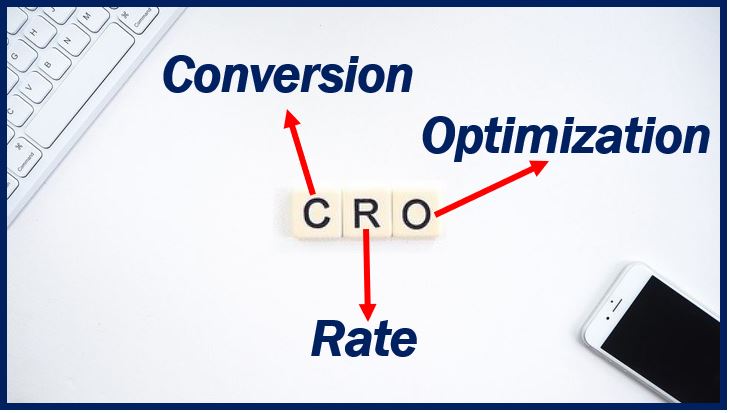What is Conversion Rate Optimization?
Normally abbreviated to C.R.O. – Conversion Rate Optimization is the process (and science) of creating a website which converts a high percentage of visitors into customers or leads.
 A website-conversion relates to the actual purpose of your website.
A website-conversion relates to the actual purpose of your website.
For example, if you are a personal trainer, your website might be designed to capture prospective clients’ contact information via an online form, whilst on an e-commerce website, a conversion would be considered as an actual online-purchase of a product.
There are many factors, tools and best practices that relate to CRO. First, we’ll take a look at some psychological principles.
The Paradox of Choice
A knowledge of psychology can certainly help when looking to optimize a given website for conversions.
The “Paradox of Choice” for example, is a very important concept for web design. When looking to make a decision, less is (usually) more. It is very easy to become overwhelmed with choice – if a potential customer is presented with too many options, he or she is less likely to make a purchase.
In a famous study, researchers compared the sales figures from a shop selling different types of jam. On days that the shoppers were given a choice of 24 types of jam, shoppers were less likely to make a purchase than on days when there were only 6 jams available to choose from.
Too much choice leads to “analysis paralysis”. This is something to bear in mind when creating a website, or a specific webpage. Huge menus with an array of options and drop-downs can overwhelm visitors. People want to make quick and easy choices, especially when it comes to lower-end, less expensive purchases.
The Fear of Missing Out
“Fear of missing out” (FOMO) is another factor to consider. A 2013 study defined FOMO as:
“a pervasive apprehension that others might be having rewarding experiences from which one is absent.”
Many websites now use countdown timers and stock figures or phrases such as ‘limited availability’ to entice website visitors into making a purchase before ‘it’s too late’.
Social Proofing
“Social proof is the influence that the actions and attitudes of the people around us (either in real life or online) have on our own behavior. The “proof” element is the idea that if other people are doing it (or saying it), it must be correct.”
With the majority of people trusting online reviews as much as friends, it is clear that social proof has a dramatic impact on the decision-making process when it comes to making online purchases.
Social proof can come in different forms. For example – Expert Social Proof relates to leveraging a review or recommendation from a prominent authority in a relevant niche. There is also User Social Proof which can be encompassed on a website in the form of case studies and/or reviews.
Remember to feature positive reviews prominently on your website, and use tools from review-platforms such as Trustpilot to add additional credibility to them. Include a number of case studies, where possible from well-known companies as this will leverage social proof which can have a dramatic impact upon CRO.
Website Speed
 Arguably the most important factor relating to CRO is customer impatience! Speed is everything. Make sure that your website loads quickly using tools such as GTmetrix and the Google page speed tester.
Arguably the most important factor relating to CRO is customer impatience! Speed is everything. Make sure that your website loads quickly using tools such as GTmetrix and the Google page speed tester.
Make sure that the customer journey; is quick, logical and problem-free too. If possible, implement checkouts using Paypal or Amazon Pay to allow customers to make easier, perhaps even more impulsive purchases on their mobile phones. Imagine you’re in work and you have 5 minutes left of your lunch hour – you’ve just remembered that you need to buy a present for a friends birthday – you can get it done and boxed-off within 5 minutes via your mobile phone if a website is fast to load and has Paypal or Amazon Pay integration.
Specific Landing Pages
Moving onto the tangible design-elements that relate to CRO…specificity is key! For example, if you are an accountant and you are running an advertising campaign with online-adverts for tax-returns; you want to send people who click on those adverts to a very specific webpage or ‘landing page’ all about tax return forms.
The page should also make it quick and easy to make an inquiry, and not overwhelm the visitor with too much choice or anything else which more cause procrastination or distraction.
Design & The Colour Wheel
A colour wheel is often used to find colour schemes. It is a way of putting together complementary colours that look good on everything from websites to the interior of your bedroom.
In terms of CRO, colour schemes can be ‘broken’ with important, clickable items that lead to a purchase – for example, an ‘Add to Cart’ button might be in a colour that is a complete mismatch to the rest of the webpage.
This is not always the case however and is something that should be tested. Other websites and e-commerce stores will make all clickable elements of a page a specific colour.
The design of a page and its layout is equally as important as the colours. Consider the positioning of key elements such as contact forms and of course, the amount of text, the complexity of the navigation and the overall user experience. If users get frustrated or confused because they cannot immediately find what they want – they will leave your site and go to a competitor.
Clear Propositions & Calls to Action
A proposition relates to Unique Selling Points (USPs) and even Strong Selling Points (SSPs). Each product or service should have at least one unique selling point, be it price, level of quality or delivery speed. The USPs should also be backed-up by a number of SSPs, which may include cashless payments, one-click-purchases or money back guarantee.
A Call to Action (CTA) is a line of text or a button that prompts a website visitor to take action. CTAs include ‘Add to Cart’ buttons on a product page or an ‘Enquire Now’ button at the bottom of a contact form.
Carry out tests using tools such as Google Optimize to see which colours and which texts work best in terms of driving sales and leads.
The placement of CTAs and CTA buttons can also have a big impact on CRO. It is generally thought of as a best practice to place CTA buttons “above the fold” of a webpage so that a user does not have to scroll down in order to carry out the desired action.
This is not always true, however, with higher value purchases requiring more information to be garnered before a visitor will commit to purchase; it can be more successful to add more information, more text and images to a page, with a CTA button below the fold.
Website Live Chat
Live chat is increasingly common on websites in 2019. A.I. live chatbots, as well as human live chat agents from the likes of Moneypenny, can be added to virtually any website. As mentioned above, online visitors are very impatient and may leave a given website if they cannot find what they are looking for immediately.
Adding live chat to a website make it easier for visitors to find what they are looking for, and human agents can offer empathy and to customers who want to complain or upsell to returning customers. It is important to consider, however, that some visitors may find a Live Chat pop-up, even in the corner of the screen annoying & intrusive, especially in addition to other intrusive adverts, cookie-notifications (in Europe, thanks to GDPR) and push-notification-requests that are common in 2019. With this in mind, it is important to test the effectiveness of live chat…
Test Everything
Always make data-driven decisions when looking to optimise conversion rate on a given website. Ideas and opinions are very important for creativity but any final decisions in terms of the website design in relation to CRO should be backed up by data.
Tools such as Google Optimize and VWO can be used to test different colours, texts and designs on specific webpages. Another tool – Hotjar can also be used to actually record what visitors are doing on your website. You can see what they click on and get an idea of why they might be leaving your website before making a purchase.
Summary
CRO is a very important aspect of web design and website optimisation. Providing a streamlined customer experience is extremely important and is in many ways, the online equivalent of customer service. It may even have a significant impact on your rankings in Google & Bing search results pages.
CRO requires creativity and empathy with the user; followed by testing of key variables – always make data-driven decisions.
One key thing to keep in mind about CRO however, is that it won’t generate traffic to your website. Remember that you require a foundation of engaged traffic in order to make a website viable and that Search Engine Optimization (SEO) and online advertising are normally a priority before CRO is – you can’t optimise a website if it does not get any visitors!
_______________________________________________________
Interesting related article: “What is Conversion Rate?”

